Eyes on the prize: Looking beyond graduate school during the 2019 MEES Colloquium
Suzanne Webster ·
Last week on October 4-5, several of us at IAN attended the annual MEES Colloquium at the Institute of Marine and Environmental Technology (IMET), which is located along Baltimore’s Inner Harbor. IMET director Russell Hill kicked off the program with a brief welcome to the impressive multi-institutional laboratory. UMCES President Peter Goodwin then followed, praising the MEES program for its ability to deliver unique “personalized” education while balancing depth and breadth for students with a wide variety of research interests. Next, Joann Boughman, the Senior Vice Chancellor for Academic and Student Affairs, shared her observation that because environmental science is “everywhere and nowhere… everyone needs to be all-in, all the time”. She encouraged us all to keep striving to “do our job well” because our job is “literally to save the planet,” and praised the MEES program for recognizing the value of public engagement (thanks for the shout-out to citizen science!) in this endeavor. Boughman's address was an excellent introduction to what seemed to be the major theme of this year's colloquium: building our careers both inside and outside of MEES.
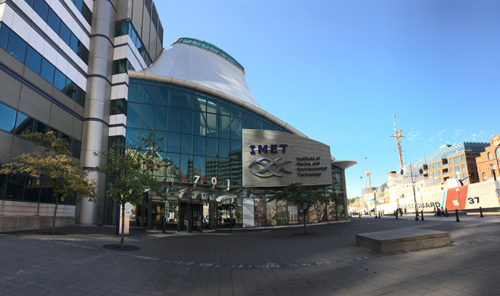
To
wrap up the morning session, newly-appointed MEES director, Tim
Canty, addressed
the full assembly of MEES faculty and students for the first time. He shared a
very relatable story about how, as a graduate student, he felt frustrated about
having to jump through hoops like building his own computer when he was eager
to start his data collection and make progress on his original research plan.
His main message to us all was that we should embrace opportunities to step
outside of our comfort zones and actively seek opportunities by “doing things
that we never wanted to do”. Dr. Canty stressed that the career path that each
of us thinks we are on right now
might be different that our eventual realities, and that is not only ok, but exciting. He encouraged us all to “reach
beyond the expected,” learn from our mistakes, and look for collaborations with
“unexpected scientific communities,” like anthropologists (another shout-out!).

Following
lunch, we listened to as series of 3-minute student talks, during which MEES
students shared an update of their ongoing research on a wide range of
subjects, including harmful algal blooms off the coast of Delmarva, bioprospecting tuberculosis drugs
in marine bacterial communities, and biofouling treatment for shellfish
aquaculture systems. Most of these topics were way, way far outside of my own
research “wheelhouse,” but luckily the students did a great job using personal
anecdotes, engaging images, and other science communication techniques to
effectively communicate their research to their diverse audience. For example,
to put a parts-per-million quantity into perspective, one student explained
that she was talking about the proportion equivalent of the phrase “I
solemnly swear I am up to no good” out of the entirety of the Harry Potter series!
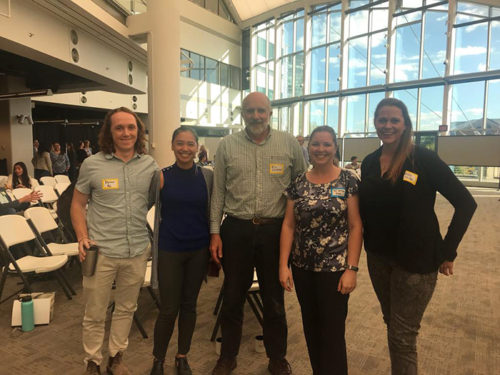
Next, two keynote speakers shared their individual paths towards their current jobs and offered advice to the students in the audience on how to build a fulfilling career. First, IMET’s Entrepreneur-In-Residence, Steve Davey, told us about his “journey into entrepreneurship” and his experience as the CEO of Fiberight, a company that specializes in recovering materials from waste and turning them into products of value, such as biofuels. His major piece of advice was to always expect the unexpected— life is full of unanticipated obstacles, and if we can learn to account for unknown unknowns ahead of time, this will save us from a lot of frustration. He also stressed the importance of finding a career that brings joy: “If you find yourself in a position where you don’t get excited when you get out of bed in the morning, find something else to do”. IAN’s Sarah Lane then told us about her own process of developing her passion, identifying her skills and strengths that make her unique and marketable, and then deliberately practicing those skills to build career capital. She emphasized the importance of being self-aware and actively working towards your passion, and reminded us that this process is cyclical and not linear because passions change.
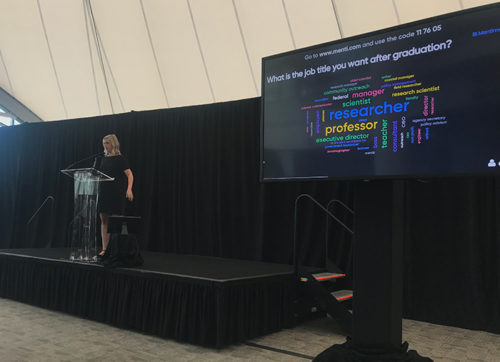
The last session of the day was a career panel with speakers representing legislative, government, non-profit, and industry career sectors. Each of the speakers shared some of their daily opportunities and challenges, including navigating a revolving political climate, collaborating in groups where you have a different background than everyone else, and dealing with delayed gratification of your work effecting change. They also encouraged us to use graduate school as an opportunity to “develop our brains” by pursuing a wide variety of experiences—even ones that are not initially appealing or an obvious fit to our skills. Policy advisor Ike Irby emphasized that “All of the things you are learning now are more important than the topic you are studying”. When panelists were asked which skills that they learned in graduate school have proven to be most valuable in their careers, they named several that stood out to me: the ability to make your knowledge and ideas understandable to others, to understand how to read people and make others feel good, and to critically think through problems, evaluate potential solutions and make a decision.
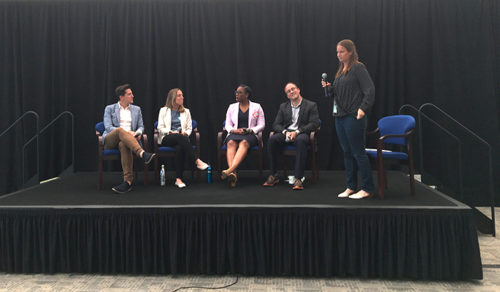
During the poster session that followed, I gave a presentation on the Chesapeake Bay SAV Watchers monitoring program that I helped develop earlier this year. My work on this project, along with ongoing follow-up research, will eventually form one chapter of my dissertation on citizen science in the Chesapeake Bay. There were many impressive posters on display and it was fun to see that so many of them featured IAN symbols in the visualizations! After an hour or so of “academic flirting,” as another student put it, we sat down for a nice dinner and a thoughtful presentation thanking former MEES director Ken Paynter and assistant director Sandy Davis for their years of service for the MEES program. The evening ended with a bar crawl through the historic Fells Point neighborhood, which was a great opportunity to relax, meet a few new friends, and catch up with others who I haven’t seen in a while.
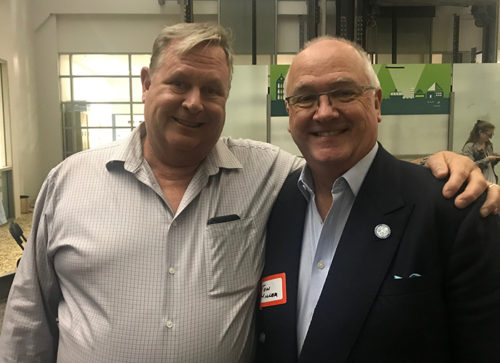
After
breakfast the next morning, we listened to one student talk from each of the
four new MEES Foundations: Earth and Ocean Systems, Ecological Systems, Environment and Society,
and Environmental Molecular Science and Technology. Topics included effects of
large storms on black sea bass movement, impacts of winds and tides on coastal
bays, prevalence of toxin/antitoxin systems in the picocyanobacteria genome,
and of course IAN’s report cards. The talks were interesting, but I think
everyone was especially excited for the field trips that would follow! There
were an impressive range of field trip options to choose from, including visits
to the Space Telescope Institute at Johns Hopkins, Fort McHenry, the American
Visionary Art Museum, and a tour of the aquaculture research spaces at IMET. Because
I love animals, especially marine species, I chose to go on a tour of the National
Aquarium Animal Care and Rescue Center in Jonesville, Baltimore.
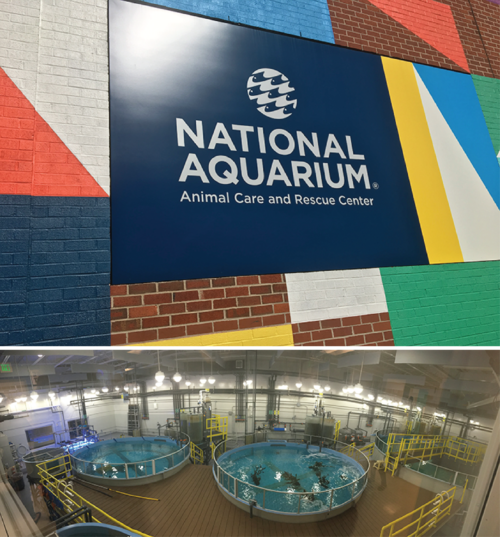
Upon our arrival, we were greeted by the Conservation Community Coordinator, who led us on an animated tour of the facility. She asked how many of us have seen the movie “Finding Dory,” and when most of us raised our hands and chuckled, she said “Great! We are like the place where Dory found her parents”. Indeed, the Animal Care and Rescue Center’s website states the facility’s purpose using the same phrase that is repeated throughout the film: “Rescue, rehabilitation, and release”. Our tour was awesome! We saw all sorts of interesting rooms, including the workshop area where rocks, corals, and trees are created for exhibits; the quarantine room where new arrivals are cared for until they move into the aquarium, and the kitchen where they raise crickets and brine shrimp and prepare treats like the “comfort food” smelt for animals who are behaving especially well. We also saw the veterinary office, the water quality lab, a seal rehabilitation chamber, and a huge room with tanks for sharks who are injured or just need a vacation from the stresses of living with the other animals in their busy exhibit (as an introvert I related to that!).
The tour was clearly designed with science communication in mind—we were each able to play with an octopus feeding puzzle and feel different biofilters. We also each received a laminated card picturing a specific animal who lives in the facility, which contained general facts about the species as well as specific information about the individual animal. For example, the subject of my card was Duncan, a map pufferfish who permanently lives in the Center because he keeps eating the artificial corals in his exhibit! Our tour guide explained to us that they like to “use the animals’ individual stories to help people form a deeper connection to the ocean”.
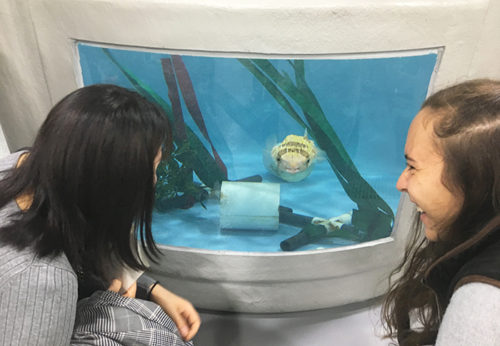
All in all, the MEES Colloquium was an inspiring and fun conference. It was great to see other students and faculty, and hear several motivating success stories from young professionals who have turned their environmental science degree into a fulfilling career. Especially as I prepare to enter into my sixth (really?!) and hopefully last year of graduate school, I appreciated the reminder to lean towards both the opportunities and the challenges that come along with pursuing a degree in higher education, and to think of getting a PhD as not just an ending, but more importantly, as an exciting beginning.
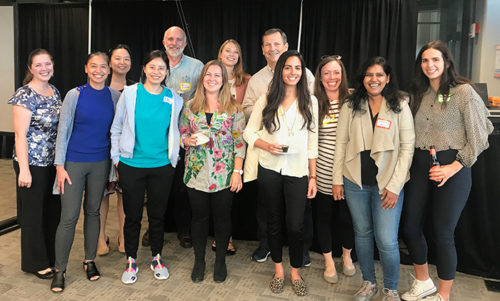
About the author
Suzanne Webster
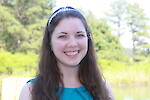
Suzi Webster is a PhD Candidate at UMCES. Suzi's dissertation research investigates stakeholder perspectives on how citizen science can contribute to scientific research that informs collaborative and innovative environmental management decisions. Her work provides evidence-based recommendations for expanded public engagement in environmental science and management in the Chesapeake Bay and beyond. Suzi is currently a Knauss Marine Policy Fellow, and she works in NOAA’s Technology Partnerships Office as their first Stakeholder Engagement and Communications Specialist.
Previously, Suzi worked as a Graduate Assistant at IAN for six years. During her time at IAN, she contributed to various communications products, led an effort to create a citizen science monitoring program, and assisted in developing and teaching a variety of graduate- and professional-level courses relating to environmental management, science communication, and interdisciplinary environmental research. Before joining IAN, Suzi worked as a research assistant at the Marine Biological Laboratory in Woods Hole, MA and received a B.S. in Biology and Anthropology from the University of Notre Dame.

